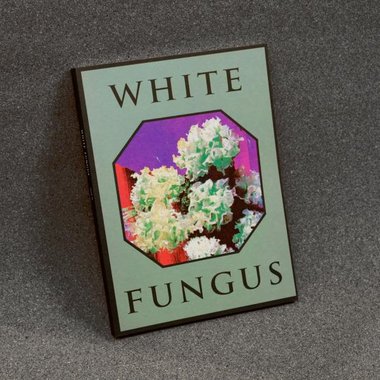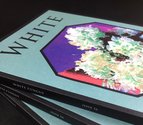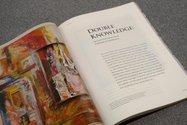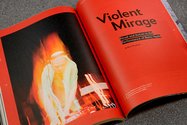John Hurrell – 15 January, 2019
This latest offering by the energetic (and insatiably curious) Hanson brothers continues their tradition of creating vividly interesting interviews with significant ‘avant-garde' heroes, left-wing persuasion, and breaking down of barriers to information flowing between East and West. The geographic sources of the content of these articles vary between the States, Taiwan, Aotearoa and Palestine.
White Fungus #16
Edited by Ron Hanson
Art directed by Mark Hanson
Contributors: Tobias Fischer, Kurt Gottschalk, Jeph Lo, Kyra Kordoski, Tim Bollinger, Nicola Trezzi, Hamish Win
224 pp, colour illistrations
Published in Taipei, Jan 2019
This latest offering by the energetic (and insatiably curious) Hanson brothers continues their tradition of creating vividly interesting interviews with significant ‘avant-garde’ heroes, left-wing persuasion, and breaking down of barriers to information flowing between East and West. The geographic sources of the content of these articles vary between the States, Taiwan, Aotearoa and Palestine.
The longest piece here is an interview with the extraordinary feminist performance and video artist, Carolee Schneemann , who is having a large survey (Kinetic Paintings) of 300 works in MoMA that includes early paintings. She had an interview in WF #12 seven years ago, but at 79 she is the kind of inspirational, historically significant, pioneering artist younger artists love to read about, having made much provocative, but thoughtful and memorable work. Articulate, gregarious and loquacious, she loves to talk about her practice, childhood, ex-partners, and cats.
I must confess I find her paintings of the early sixties too close to a synthesis of de Kooning and Rauschenberg, but her later films and performances are sensational, the artist herself, immensely candid, informative and likeable. Schneemann’s pencil drawings of a young woman dancing (done when she was seven) are fantastic. My favourite images in the publication.
Hamish Win contributes ‘The Laughing Song,’ a terrific essay on Luke Willis Thompson, pointing out lots of cross-connections between a wide range of Thompson works, mixing in some theory from Pierre Bourdieu, and then in a final flourish, channelling it through the musical obsessions of some record-collecting characters in Hari Kunzru’s novel White Tears. Though Win loves to produce densely convoluted texts packed with irritating diversions and oblique references—and is sometimes dry—I found myself hanging in with this one, it was so interesting.
The interview Nicola Trezzi conducts with Dor Guez looks at an archive of manipulated photographs that explores questions of ‘minorities within minorities’, complex notions of identity inside sub-groups within marginalised Arab communities. Guez was born in Israel with a Christian Palestinian mother and a Tunisian Jewish father, and his Christian Palestinian Archive focusses on awkward tensions inherent within dominant nationalist agendas, inviting a range of families to have their collected photographs scanned and incorporated. His treated photos of his mother are particularly haunting.
Jeph Lo’s article ‘Wasteland Utopia’ on the growth of Taiwanese noise bands in the wake of the abandoning of martial law in 1987 that enforced regulations on music and even things as trivial as male and female hair length, will be an eye opener for most New Zealand readers. Lo elaborates in detail on the subsequent growth of a proliferating counter-culture that celebrated new musical forms. The photos alone of festival crowds and earlier street riots (such as fighting between rival taxi companies, or angry farmers barricading against the police) are extraordinary.
Another article—by Kurt Gottschalk—instead of examining unrest and community conflict, looks at relaxation and sleep, and music that is designed to be listened to in bed, even when the ‘listener’ is not awake. The composer Max Richter has created works where the audience are in bed during a concert (surrounding the performing musicians of the American Contemporary Music Ensemble) and sleep is encouraged. This raises questions about the experience, if that is what you can call it, and what its benefits might be.
The most important article in this issue, I think, is ‘The Pleasure Principle’, Tobias Fischer’s immensely interesting look at the nature of animal vocalisations (especially of certain birds and mammals), whether they can be termed ‘music’—and whether issues like purpose/functionality, innovation, and pleasurable creativity (involving say, dopamines) need to be considered. As someone who likes to collect cds of recorded animal sounds in forests etc, thinking of them as ‘found music,’ I consider this essay about the biology of nonhuman aesthetics—with its interviews with various scientists—a treat, useful for pondering questions that anybody who walks through leafy suburbs a lot (like I do) will keep asking.
John Hurrell




 Advertising in this column
Advertising in this column Two Rooms presents a program of residencies and projects
Two Rooms presents a program of residencies and projects



This Discussion has 0 comments.
Comment
Participate
Register to Participate.
Sign in
Sign in to an existing account.